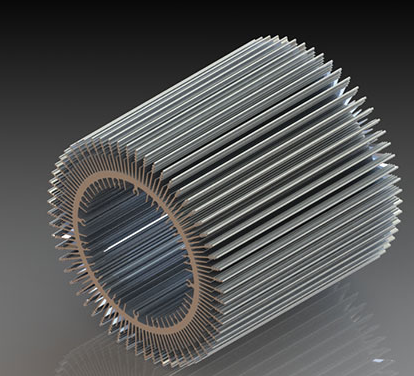Comparative analysis of 5 types of radiators for LED lighting fixtures

The following is a comparative analysis of Category 5 LED heatsinks.
1.Die-cast aluminum radiator
The production cost is controllable, the heat dissipation fins cannot be made thin, and it is difficult to maximize the heat dissipation area. LED lamp radiators commonly used die-cast materials for ADC10 and ADC12.
2. Extruded aluminum radiator
The liquid aluminum is extruded through a fixed mold, and then the bar is machined into a heat sink of a desired shape, and the processing cost is high. The extruded aluminum heat sink is shown in Figure 3. The heat dissipating wings can be made a lot of thin, and the heat dissipating area is maximized. When the cooling fins work, the air convection heat is automatically formed, and the heat dissipating effect is better. Common materials are AL6061 and AL6063.
3. Stamped aluminum radiator
It is stamped and pulled up by steel plate and aluminum alloy by punching machine and die, making it a cup-type radiator. The inner and outer periphery of the stamped heat sink is smooth, and the heat-dissipation area is limited due to the wingless. Commonly used aluminum alloy materials are 5052, 6061, 6063. The quality of stamping parts is small and the material utilization rate is high, which is a low-cost solution.
The heat conduction of the aluminum alloy heat sink is ideal, and is suitable for the isolated switching constant current power supply. For non-isolated switch constant current power supply, it is necessary to isolate AC and DC, high voltage and low voltage power supply through the structural design of the luminaire, in order to pass CE or UL certification.
4. Plastic coated aluminum radiator
It is a heat sink with a heat-conductive plastic outer casing aluminum core. The heat-conducting plastic and the aluminum heat-dissipating core are formed on the injection molding machine at one time, and the aluminum heat-dissipating core is embedded, and it is required to be machined in advance. The heat of the LED lamp bead is quickly transmitted to the heat-conducting plastic through the aluminum heat-dissipating core. The heat-conductive plastic uses its multi-wing to form air convection heat, and uses its surface to radiate part of the heat.
Plastic aluminum radiators generally use the original color of thermal conductive plastic white and black, and the plastic radiation aluminum radiator of black plastic has better radiation dissipation effect. Thermally conductive plastic is a thermoplastic material. The fluidity, density, toughness and strength of the material are easy to be injection molded. It has good resistance to cold and heat shock cycles and excellent insulation performance. Thermally conductive plastics have better emissivity than ordinary metallic materials. The thermal conductive plastic density is 40% smaller than that of die-cast aluminum and ceramics. The weight of the same shape of the heat sink can reduce the weight of the plastic-coated aluminum by nearly one-third; compared with the all-aluminum heat sink, the processing cost is low, the processing cycle is short, and the processing temperature is low; The finished product is not easy to break; the customer-supplied injection molding machine can carry out the differential shape design and production of the lamps. The plastic-coated aluminum heat sink has good insulation performance and is easy to pass the safety regulations.
5. High thermal conductivity plastic radiator
High thermal conductivity plastic radiator has recently developed rapidly. High thermal conductivity plastic radiator is a full plastic radiator. Its thermal conductivity is several times higher than that of ordinary plastic, up to 2-9w/mk, and it has excellent heat conduction and heat radiation capability. The new insulating heat dissipating material that can be applied to various power lamps can be widely used in various types of LED lamps from 1W to 200W.
High thermal conductivity plastic withstand voltage up to 6000V AC, suitable for non-isolated switching constant current power supply, HVLED high voltage linear constant current power supply. This type of LED lighting fixture is easy to pass the strict safety inspection of CE, TUV, UL and so on. The HVLED uses a high voltage (VF=35-280 VDC) and a small current (IF=20-60 mA) to operate, and the heat of the HVLED lamp bead is reduced. The high thermal conductivity plastic radiator can be used in traditional injection molding and extrusion machines. Once formed, the finished product has a high finish. Greatly improve the efficiency of the production, the flexibility of the design is high, and the designer's design concept can be fully utilized. The high thermal conductivity plastic radiator is made of PLA (corn starch)

